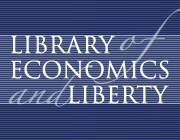
In that same book Mises also argued that business cycles were caused by the uncontrolled expansion of bank credit. In 1926 Mises founded the Austrian Institute for Business Cycle Research. His most influential student, who later developed Mises' business cycle theories, was Friedrich Hayek.
Another notable contribution by Mises was his claim that socialism must fail economically. In a 1920 article Mises argued that a socialist government could not make the economic calculations required to organize a complex economy efficiently. Although socialist economists Oskar Lange and Abba Lerner disagreed with Mises, modern economists agree that Mises' argument, combined with Hayek's elaboration of it, is correct (see Socialism).
Mises believed that economic truths are derived from self-evident axioms and cannot be empirically tested. In his magnum opus, Human Action, and in other publications, Mises laid out these views. His view failed to persuade many economists outside the Austrian school. Mises was also a strong proponent of laissez-faire; he advocated that the government not intervene anywhere in the economy. Interestingly, though, even Mises made some striking exceptions to this view. For example, he believed that military conscription could be justified in wartime.
Mises was rare, for someone of his stature within the economics profession, in not having a paying academic job for much of his professional life. From 1913 to 1934 Mises was an unpaid professor at the University of Vienna. His salaried job from 1909 to 1934 was as an economist for the Vienna Chamber of Commerce, in which capacity he served as the principal economic adviser to the Austrian government. To avoid the Nazi influence in his Austrian homeland, in 1934 Mises left for Geneva, where he was a professor at the Graduate Institute of International Studies until 1940. In 1940 he emigrated to New York City. He was a visiting professor at New York University from 1948 until he retired in 1969. During those years his salary was paid by a private foundation.
Not only did Mises not have a regular tenure-track academic job, but his ideas—on economic reasoning and on economic policy—were out of fashion during the Keynesian revolution that took over American economic thinking from the midthirties to the sixties. Possibly both factors made Mises bitter from the late forties on, something that was not true early in his professional life. The contrast between his early view of himself as a mainstream member of his profession and his later view of himself as an outcast shows up starkly in The Theory of Money and Credit. The first section, written in 1912, is calmly argued; the last section, added in the forties, is strident.
Mises had a strong influence on young people. A resurgent Austrian school in the United States owes itself in no small part to Mises' persistence.
The Theory of Money and Credit. 1912. 3d English ed. 1981.
"Economic Calculation in the Socialist Commonwealth." 1920. Reprinted in Collectivist Economic Planning: Critical Studies on the Possibilities of Socialism, edited by Friedrich Hayek. 1935.
Finance and Banking in the Austrian Empire and Republic of Austria, two articles from the 12th edition of the Encyclopedia Britannica. 1921.
Socialism. 1922.
Omnipotent Government: The Rise of the Total State and Total War. 1944. Reprint. 1985.
Mises, Ludwig von. Human Action: A Treatise on Economics. 1949.
-
Human Action: A Treatise on Economics, 3d ed. 1966.
Human Action: A Treatise on Economics. Fourth revised ed., 1996.
Foreword to The Economic Point of View, by Israel M. Kirzner. 1960.
Liberalism: The Classical Tradition Bettina Bien Grieves, ed.
Literature of Liberty: Editorial with Bibliography
The Economic Point of View, by Israel M. Kirzner


